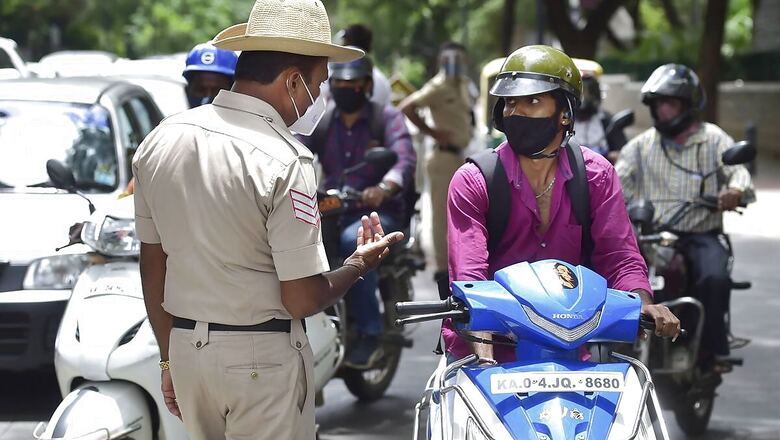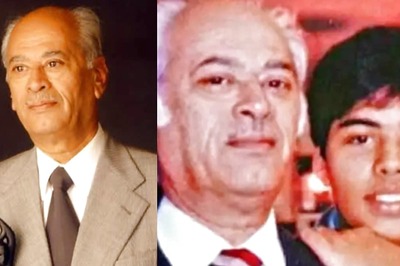
views
Attributing the decline in the number of cases to coronavirus curbs, the Union home ministry on Thursday extended the nationwide Covid-19 restrictions, which was imposed after its April 29 order, till June 30. The government asked state and union territories to go for intensive and local containment measures in districts with a high number of cases to check the spread of the deadly disease.
In a fresh order, Union Home Secretary Ajay Bhalla said strict implementation of containment and other measures has led to a declining trend in the number of new and active cases, across states and union territories, barring some areas in the southern and northeastern regions.
“I would like to highlight that in spite of the declining trend, the number of active cases presently is still very high. It is, therefore, important that containment measures may continue to be implemented strictly. “Any relaxation by states and UTs, may be considered at an appropriate time, in a graded manner, after assessing the local situation, requirements and resources,” Bhalla said in his order issued to chief secretaries of the states and union territories.
He said the guidelines issued on April 29 for the month of May will continue till June 30. According to the guidelines, the home ministry told the states to take necessary action to ensure sufficient oxygen-supported beds, ICU beds, ventilators, ambulances including creation of makeshift hospitals, oxygen, as needed, besides sufficient quarantine facilities.
The home ministry, however, did not mention anything about the imposition of lockdown anywhere in the country in the fresh guidelines issued in view of the pandemic. The fresh guidelines for Covid-19 management came amid some decline in the daily count of the coronavirus cases and improvements in the situation of the availability of the beds, ICU and oxygen in some parts of the country like Delhi.
India’s Covid-19 infection tally climbed to 2,73,69,093 as 2,11,298 more people tested positive for the disease in a day, while the country’s recovery went up to 90 per cent, according to the Union health ministry on Thursday. The death toll due to the disease rose to 3,15,235 with 3,847 fresh fatalities being reported in a span of 24 hours, the data updated at 8 am showed.
The home ministry asked the states and union territories to identify the districts where either the Covid positivity rate was more than 10 per cent or the bed occupancy was over 60 per cent in the last one week. The districts fulfilling any of the above two criteria should be considered for taking intensive and local containment measures, a statement issued by the MHA said.
The MHA also asked the states to consider the containment measures, as conveyed in an advisory issued by the Ministry of Health and Family Welfare on April 25 for immediate implementation based on an assessment of the situation. It said focus will be on containment as a major approach to flatten the current curve of the epidemic.
Movement of individuals shall be strictly prohibited during night hours, except for essential activities in areas where number of cases high. The spread of the infection has to be controlled through restricting the intermingling among people, the only known host for the COVID-19 virus, the guidelines said.
Social, political, sports, entertainment, academic, cultural, religious, festival related and other gathering and congregations have been prohibited. Marriages should be attended by up to 50 people and funerals should be attended by a maximum of 20 people.
All shopping complexes, cinema halls, restaurants, bars, sports complexes, gym, spas, swimming pool and religious places should remain closed. Essential services and activities such as healthcare services, police, fire, banks, electricity, water and sanitation, regulated movement of public transport including all incidental services and activities needed for a smooth functioning of these activities shall continue. Such services shall continue in both public and private sector, the guidelines said.
Public transport like railways, metros, buses, cabs will operate at a maximum capacity of 50 per cent. There shall be no restrictions on inter-state and intra-state movement including transportation of essential goods.
All offices, both government and private, to function with a maximum staff strength of 50 per cent. All industrial and scientific establishments, both government and private may be allowed subject to the workforce following physical distancing norms.
They shall also be tested through Rapid Antigen Test in case of individuals identified with flu like symptoms from time to time. However, states and union territories should make a careful analysis of the local situation, areas to be covered, and probability of transmission and then take a decision.
Referring to the testing and surveillance, the guidelines said districts will continue with the strategy of ‘Test-Track-Treat-Vaccinate’ and implementation of Covid appropriate behaviour across the district as the ongoing strategy for the management of COVID-19. “Ensure adequate testing and door to door case search in the area through adequate number of teams formed for such purpose,” the home ministry said.
The guidelines said analysis has to be undertaken with respect to requirement of health infrastructure so as to manage the present and projected cases (next one month) and necessary action initiated to ensure sufficient oxygen-supported beds, ICU beds, ventilators, ambulances including creation of makeshift hospitals, as needed. Sufficient quarantine facilities shall also be re-activated. States should leverage government, private health facilities including hospital facilities available with central ministries, railway coaches, temporary field hospitals etc.
States should ensure that people satisfying protocol for home isolation only are allowed under home isolation and create a mechanism for their regular monitoring through call centres along with regular visit of surveillance teams to such houses. Specific monitoring shall be done for high risk cases and their timely shifting to the health facility, it said.
Similarly, elderly and co-morbid contacts of positive cases shall be shifted to quarantine centres and monitored. States should also ensure availability of sufficient ambulances for such purpose and coordinate availability of oxygen, other related logistics, drugs etc. in collaboration with state officials and ensure their rational use.
Oxygen therapy for the admitted cases shall follow the guidelines issued by Ministry of Health on the rational use of oxygen, it said. Facility wise cases and deaths shall be analysed on daily basis by the incident commander, district collector, municipal commissioner. Death audit shall be undertaken for all deaths in the hospitals and in the community to provide supportive supervision to field staff and hospitals.
States should ensure 100 per cent vaccination for the eligible age-groups. Details of hospital beds and their vacancy status should be made available online and also released to media on a daily basis.
Read all the Latest News, Breaking News and Coronavirus News here. Follow us on Facebook, Twitter and Telegram.




















Comments
0 comment